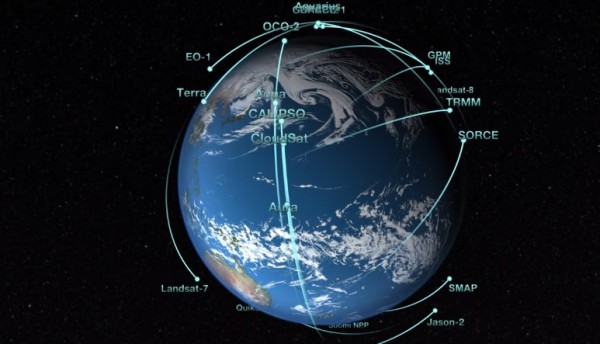NASA Video Reveals How Their Satellites Observe Earth 24/7
| Ana Verayo | | Mar 10, 2015 09:08 AM EDT |
(Photo : Goddard Space Flight Center ) These NASA Earth orbiting satellites observe the planet and gather important data.
NASA has just released a video that will take viewers into an incredible view of the space agency's fleet of Earth observation satellites and how they orbit the planet.
Satellites gather data about Earth as they roam the planet in low Earth orbit, about 400 miles above the surface of the planet. This unique visualization was prepared by the Goddard Space Flight Center in Maryland. This animation, however, only shows NASA satellites, leaving out other international space agencies' satellites.
Like Us on Facebook
This animation was taken over a period of 12 hours last February 16 and features eight of the satellites' orbits as each circles the Earth for an hour and a half.
These satellites each have different tasks. Some measure precipitation from rainfall to snowfall. Others observe cloud formations, ocean surface levels and salinity, solar heat absorbed by the planet's surface and other meteorological and climate changes and patterns.
NASA says that together with the ground observing satellites, these Earth orbiting satellites provide a better look of the planet as an entire system.
Most of these satellites are in polar orbits so they cover the entire planet as it rotates beneath them. Some satellites travel a different kind of orbit called a solar-synchronous orbit that allows them to gather information from the same spot on Earth during each local time of the day.
Satellites in this solar orbit are called the "A-train" and consist of the satellites Aqua, Aura, CALIPSO and CloudSat flying in relatively close proximity. CloudSat and CALIPSO are just 58 miles apart.
NASA confirms that even if they're orbiting within the same plane, they're still at a safe distance since following each other rather closely provides a particular benefit.
These four "A-train" satellites are also equipped with 15 scientific instruments that gather data from the same spots on Earth at the same local times and compare them with each other for a more detailed observation.
According to Ernie Wright from Goddard, this group of satellites act like one satellite with 15 instruments onboard. Even if they're all orbiting closely, there's almost no chance any of them will collide since each is specifically programmed with a certain amount of "elbow room" in space.
TagsNASA Video Reveals How Their Satellites Observe Earth 24/7, NASA, NASA video satellites, NASA video satellites orbiting Earth planet
©2015 Chinatopix All rights reserved. Do not reproduce without permission
EDITOR'S PICKS
-

Did the Trump administration just announce plans for a trade war with ‘hostile’ China and Russia?
-

US Senate passes Taiwan travel bill slammed by China
-

As Yan Sihong’s family grieves, here are other Chinese students who went missing abroad. Some have never been found
-

Beijing blasts Western critics who ‘smear China’ with the term sharp power
-

China Envoy Seeks to Defuse Tensions With U.S. as a Trade War Brews
-

Singapore's Deputy PM Provides Bitcoin Vote of Confidence Amid China's Blanket Bans
-

China warns investors over risks in overseas virtual currency trading
-

Chinese government most trustworthy: survey
-

Kashima Antlers On Course For Back-To-Back Titles
MOST POPULAR
LATEST NEWS
Zhou Yongkang: China's Former Security Chief Sentenced to Life in Prison

China's former Chief of the Ministry of Public Security, Zhou Yongkang, has been given a life sentence after he was found guilty of abusing his office, bribery and deliberately ... Full Article
TRENDING STORY

China Pork Prices Expected to Stabilize As The Supplies Recover

Elephone P9000 Smartphone is now on Sale on Amazon India

There's a Big Chance Cliffhangers Won't Still Be Resolved When Grey's Anatomy Season 13 Returns

Supreme Court Ruled on Samsung vs Apple Dispute for Patent Infringement

Microsoft Surface Pro 5 Rumors and Release Date: What is the Latest?










